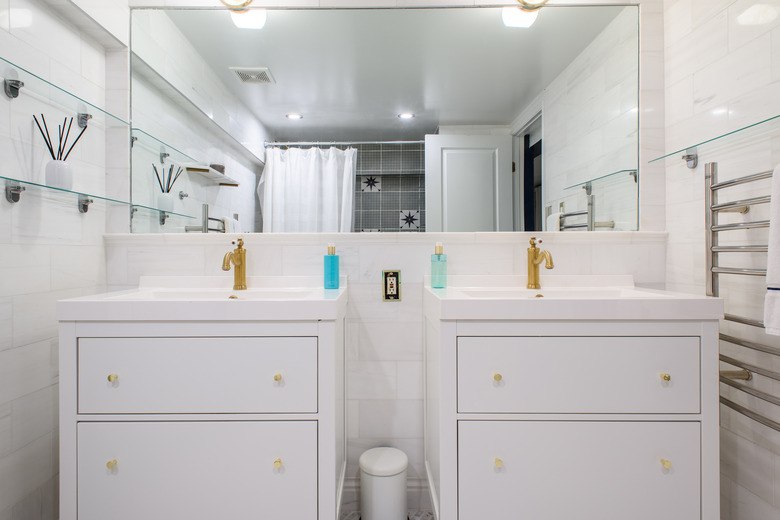How To Attach A Marble Top To A Wood Vanity
No rule says you have to attach your new marble countertop to your wood bathroom vanity. The density of marble is 169.2 pounds per cubic foot, so a fairly small countertop measuring 24 x 72 inches, or 12 square feet, with a thickness of 3/4 inches, tips the scale at a little under 127 pounds, and if you've ever tried lifting something that heavy, you know it would much rather stay put. You could simply set the countertop on the vanity, caulk it to the wall and trust it to stay where it is, and it probably will. Most contractors prefer a guarantee of permanence, however, and they either glue down marble countertops or attach them with brackets.
Attach the Countertop With Glue
The most common way to attach a marble countertop is to glue it to the top of the cabinet frame using silicone caulk or construction adhesive. This is a permanent installation, so if you're installing an undermount sink or drilling holes for a faucet, it's best to complete this work first. The addition of a sink makes the countertop heavier, but it was already heavy enough to require two people to lift it, so not much has changed.
Install the countertop on the cabinet after the cabinet has been leveled and anchored to the wall. Start by turning over the countertop on a pair of sawhorses and wiping down the underside with alcohol to remove any oils or grease that could interfere with adhesion. Apply a bead of silicone caulk or construction adhesive to all the exposed top edges of the cabinet frame using a caulking gun. Together with your helper, carefully turn the countertop upright, position it over the cabinet as closely as possible to where you want it and set it down. Wear rubber gloves for safety.
After placing the countertop you'll probably have to fine-tune its position, and you can do this by sliding it. When it's flush against the wall and centered, let it sit overnight so the adhesive can set. Then, caulk the edges that are against walls and install the backsplash.
Glue the Countertop to Plywood
If you want an installation method that isn't quite as permanent, consider gluing the countertop to a sheet of 1/2-inch sanded plywood that you can remove. This will raise the height by the thickness of the plywood, so plan accordingly. To avoid visible plywood edges, the plywood should extend to the edges of the vanity but no farther.
If you've already attached an undermount sink to the countertop, prepare the plywood by tracing and cutting the sink opening with a jigsaw. Make the hole a little larger than necessary to prevent the sink from getting stuck when you lower the countertop onto the cabinet. To make the plywood removable, glue strips of wood to the underside with construction adhesive and use those to attach the plywood by driving screws through them into the cabinet frame.
Spread beads of caulk or adhesive liberally on the plywood, set the countertop in place on top of it and slide it into position. Wait for the glue to set before connecting the plumbing and installing the backsplash.
Attach the Countertop With Brackets
A third option is to glue brackets to the marble and screw the brackets to the vanity frame. You can purchase kits that include the brackets and glue you need, or you can do it yourself with steel corner brackets and two-part epoxy.
Set the countertop in place and glue the brackets to the underside in several places next to the cabinet frame. There should be at least two in the back and on each side and one or two in the middle. Let the epoxy set for several hours and then drive screws through the brackets into the cabinet frame. Always wear goggles when driving screws.
